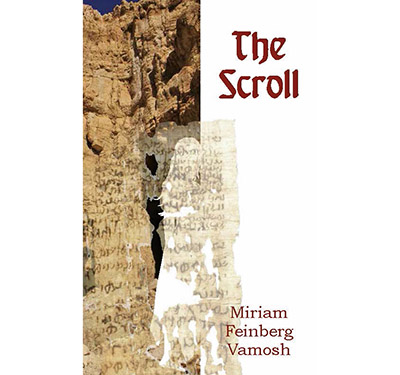
Excerpting: “The Scroll,” by Miriam Feinberg Vamosh. Menorah Books, 294 pages. 2016. ISBN-10: 1940516633.
Whether it’s fly-fishing or forensics, Masada or massage therapy, there’s nothing more frustrating than reading popular articles on a subject about which you happen to know something, because you’ll always find mistakes. The same is true of historical novels. There you are, deep in the twists and turns of an exciting plot, the characters hobnobbing with the famous figures of bygone days, when you are stopped in your tracks. Your favorite character meets a king, queen or priest that has long been dead by the period of the novel’s setting. That is why God invented research, as I discovered when I did the work for my first historical novel, “The Scroll.”
My story begins on the day the desert fortress of Masada fell to the Romans, as described by the first-century historian Josephus. Even though historians have been debating for years whether Josephus himself ever strayed from truth, they explain that if and when he did, he had an agenda and a Roman literary style to adhere to. Lucky for him he didn’t have anyone looking up all his facts on Google.
According to Josephus, the leader of the rebels at Masada, Elazar, persuaded his men to take their families’ lives and then kill themselves. Two women and five children survived.
Despite Masada’s fame, most folks never heard about the fascinating document that was issued at Masada: an ancient Jewish divorce document, revealing that a couple must have split up right at Masada during the Roman siege. The document was discovered in a cave in the Judean Desert back in 1951.
Wearing my other hat as a tour guide, I’ve brought thousands of people to Masada over the years. Toward the end of the tour, when I tell them about the women and children survivors, they inevitably ask: “What happened to them?”
I, too, was curious about them. Thus came my first leap from history to creating historical fiction. I imagined that the divorce document belonged to one of the two women survivors whom Josephus describes as a relative of the commander, Elazar. She was, the historian tells us: “in intelligence and education superior to most women.” Her real name, I discovered, was the same as mine: Miriam.
As a writer, I decided to embrace that historical fact, and treat the plot as a modern Miriam putting herself in the sandals of an ancient one. Was this a legitimate leap? I needed an expert to tell me, so I cold-called Magen Broshi, then-curator of the Shrine of the Book at the Israel Museum, where the Dead Sea Scrolls are exhibited. I told him about my plan to a write historical novel based on the narrative of this Masada divorce scroll. In typically curt Israeli fashion, he answered: “You can do what you want. We have no idea what happened to her.”
So I delved into this plot-in-the-making. I read everything I could by reputable scholars who specialized in ancient life in the Holy Land. Coincidentally, at around the same time I started my research, I was commissioned to write a series of books on life in Biblical times. That work, overseen by experts, helped bring my characters to life, hopefully as accurately as possible.
Not all of my research was about the minutiae of daily life. Some of the characters in “The Scroll” interact with real historical figures—Jewish sages and Roman officials alike. And so, as my characters evolve over three generations, all over the Holy Land and as far afield as Alexandria, meeting other Jews, pagans and early Christians, I tried to make sure that the historical figures they encounter lived when I said they lived, could have been in the places I put them and spoke the words I imagined.
What’s more, I have the privilege of living in the land that I focus upon in my writing. Sunrise over the Dead Sea, the aroma of hyssop that perfumes the air on rainless summer mountainsides, the antiquities and their wise and loving reconstructions are all part of my own daily life.
When I thought I was done writing, I asked an expert to read the manuscript. My contact was a Ph.D. student in Jerusalem, who is now a professor in California. He pointed out that my character, “climbing over the ruined walls” was more fictional than historically accurate. Indeed, it was how I imagined the location based on my hundreds of visits to Masada of today. “They weren’t ruined in those days,” I recall him gently reminding me.
Historical fiction or fictional history: Readers want the authors of their favorite genre to respect the difference. If we fulfill that obligation—by delving into the details of every aspect of our chosen era and delivering them faithfully—we’ll find our characters truly coming to life, for us and for our readers.
By Miriam Feinberg Vamosh
Miriam Feinberg Vamosh is the author of several informative, illustrated books about ancient times in the Holy Land that have been translated into more than 30 languages. Her latest book, “The Scroll,” is published by Menorah Books. Writing about events that took place millennia ago, together with her work as translator for the Israel’s daily newspaper, Haaretz, are part and parcel of the complexities that, for Miriam, make life in Israel a never-ending search for meaning.













